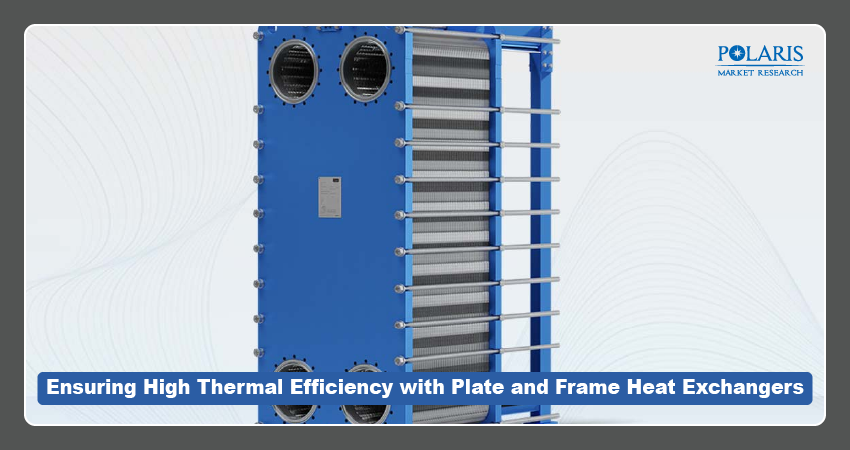Ensuring High Thermal Efficiency with Plate and Frame Heat Exchangers

The global demand for energy is increasing. There is also a growing focus on sustainability. This has led to increased adoption of energy systems. Plate and Frame Heat Exchangers allow for energy transmission between two fluids at different temperatures. This helps in improving efficiency through heat transfer.
This blog post explains all that you need to know about plate and frame heat exchangers. It covers the basics, working, and uses of these heat exchangers. The key plate and frame heat exchanger market metrics and growth drivers have also been detailed. Keep reading!
Heat Exchangers: Overview
A heat exchanger is a device used for the transfer of heat between two fluids. Here, the mixing of the fluids doesn’t take place. Also, the fluids are at different temperatures. Most exchangers have a coiled pipe that allows the fluid to pass through another chamber holding the fluid. The walls of the pipe are made of metal or any other material having a high thermal conductivity. The chamber holding the pipe is made of plastic to prevent the heat from escaping. Sometimes, the chamber of heat exchangers from the heat exchangers market may be coated with thermal insulation.
Plate and Frame Heat Exchangers: Introduction
Plate and frame heat exchangers are heat exchangers that transfer heat between two separate fluids without letting them mix. These heat exchangers are less bulky than the shell-and-tube systems available in the shell and tube heat exchanger market. Instead, they make use of a compact arrangement of thin and corrugated metal plates. These plates are stacked together within a rigid frame. Each plate allows for the efficient transfer of heat and keeps the fluids isolated from each other.
The design of these heat exchangers allows for fluid flow through alternating channels. Here, one of the channels carries the hot fluid and the other carries the cold one. This creates a counterflow pattern that maximizes the efficiency of heat exchange. The thermal energy released by the hot fluid through the metal plate is absorbed by the cooler fluid on the opposite side. This allows for rapid equalization of temperature.
Plate and Frame Heat Exchangers Types
Brazed Plate Heat Exchangers
Brazed plate heat exchangers are hermetically sealed units. They have thin stainless-steel plates that are permanently joined with the use of a brazing material. The brazing process takes away the need for gaskets or external frames. As such, these heat exchangers are capable of withstanding high-pressure and temperature conditions. Brazed plate heat exchangers are durable and have high thermal efficiency. They are suitable for use in HVAC systems and refrigeration units. The absence of replaceable parts here keeps maintenance requirements minimal.
Gasketed Plate Heat Exchangers
Gasketed plate heat exchangers are known for their versatility. They have a series of corrugated plates, which are all clamped in a bolted frame. Flexible gaskets seal the flow paths and direct the hot and cold fluid through alternating channels. This guarantees that the heat transfer is performed with great effectiveness. One strength of this heat exchanger design is that it is modular. It allows for an increase or decrease in capacity by adding or removing plates. Gasketed plate heat exchangers are also exceptionally easy to clean, inspect, and maintain.
Welded Plate Heat Exchangers
Welded plate heat exchangers combine thermal efficiency with plate technology and the rugged nature of welded construction. This design enables a leak-free solution for demanding environments. In this heat exchanger, the plates are welded together to form a sealed flow path with high-pressure and temperature handling capabilities. The use of these heat exchangers is common in petrochemical processing and power generation, as well as in industries that require safe operation and a longer service life.
Plate and Frame Heat Exchanger Market Metrics
We’ve done a detailed analysis of the plate and frame heat exchanger market. Our analysis reveals the market for these heat exchangers stood at USD 6.04 billion in 2024. The market is projected to account for a CAGR of 6.72% between 2025 and 2034.
Emerging innovations in materials and designs have made plate and frame heat exchangers more durable and heat-resistant. This, in turn, is driving their increased demand. The market is also benefiting from rising industrialization and growing urbanization in emerging nations globally.
Plate and Frame Heat Exchangers Benefits
High Efficiency
The corrugated plate design of these heat exchangers creates a large heat transfer surface area. Also, it allows for highly efficient heat exchange by encouraging the turbulent flow of fluid. The size and material required here are smaller than those of traditional systems to achieve the same level of performance.
Compact and Lightweight
Plate and frame heat exchangers are compact and lightweight. This makes them suitable for use in environments with limited space. Additionally, the modular construction of these heat exchangers means it's easy to expand capacity through the addition of plates.
Easy Maintenance
Quick disassembly of plate and frame units can be done for cleaning and inspection. This helps reduce downtime and the cost of maintenance. Also, it reduces the risk of contamination. As such, plate and frame heat exchangers are valuable for industries that have high hygiene standards.
Flexibility in Operation
Plate and frame heat exchangers are capable of handling various fluids and pressures. This makes them suitable for gentle and aggressive heat transfer applications. The modular structure of these heat exchangers means customization can be done based on specific performance needs.
Conclusion
To conclude, plate and frame heat exchangers offer an efficient and reliable way for transferring heat between two fluids. These heat exchangers are used in various applications. They are often used in environments with limited space. The major participants in the plate and frame heat exchanger market are increasingly focusing on technological advancements and efficiency optimization for offering more innovative solutions.

